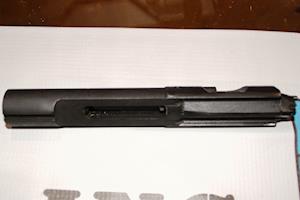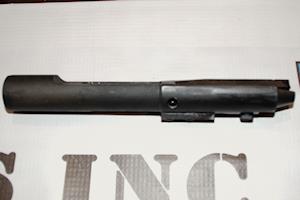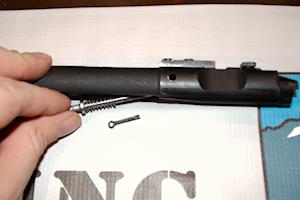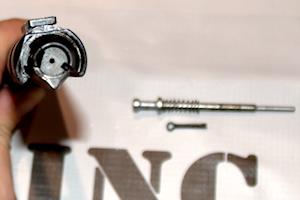A Quick Glance at the Olympic Arms 9mm AR System
At the 2013 SHOT show, I finally got to get some hands-on time with an Olympic Arms 9mm AR. Olympic uses a blowback operated design, and its design is different from the more commonly encountered Colt / RRA / CMMG 9mm AR system. What attracts me to the Olympic system is that with the use of the Kurt's Kustom Firearms magblock, one is able to use unmodified 9mm Sten magazines instead of Olympic's magazines. The Colt / RRA / etc system allows you to use Uzi magazines, but they must be modified from their original design, which is unattractive to Californians with pre-ban magazines. While it should be perfectly legal to modify a magazine in CA to operate in a different firearm, particularly when it remains compatible with the existing firearm, it's always possible to run into an officer who believes otherwise. The ability to use unmodified magazines is a benefit in that situation, particularly if (like me) your grandfather left you a box of World War 2 era magazines, including Sten mags. I regret that I was unable to get my customary level of detail with these pictures. I met the owner of Olympic Arms, who was a very nice gentleman and perfectly happy to let me take apart his upper for these photos. However, I was using a camera I hadn't had a lot of time with, and the focus wasn't that great in most of these pictures. I hope to re-shoot this at the 2014 SHOT show. For an overview of the competing Colt 9mm system, please check out my analysis of an RRA 9mm AR upper.The Bolt Carrier
 This is a view of the bolt carrier's underside. Note that the bolt face of the Olympic system comes down to a cone or pyramid on the front, as opposed to being a "cup".
This is a view of the bolt carrier's underside. Note that the bolt face of the Olympic system comes down to a cone or pyramid on the front, as opposed to being a "cup".
 A view of the top side. Note that the carrier key area exists, but is basically just a plug. I don't think it does anything in this design other than maintain vertical alignment as it reciprocates in the upper during operation. There's a cam pin like protrusion on the front of the bolt carrier, but notice that it doesn't actually travel. You can also see the bolt cone a little more clearly towards the front of the bolt carrier.
A view of the top side. Note that the carrier key area exists, but is basically just a plug. I don't think it does anything in this design other than maintain vertical alignment as it reciprocates in the upper during operation. There's a cam pin like protrusion on the front of the bolt carrier, but notice that it doesn't actually travel. You can also see the bolt cone a little more clearly towards the front of the bolt carrier.
 Inverted view of the left side. Note that the disassembly pin is located exactly where it would normally be in a standard bolt carrier.
Inverted view of the left side. Note that the disassembly pin is located exactly where it would normally be in a standard bolt carrier.
 Removing the pin, one can remove the firing pin. Note that the firing pin is spring-loaded to ensure that it avoids denting primers when going forward. This is to avoid setting off light primers.
Removing the pin, one can remove the firing pin. Note that the firing pin is spring-loaded to ensure that it avoids denting primers when going forward. This is to avoid setting off light primers.
 The spring-loaded firing pin and the cotter pin, below the bolt carrier.
The spring-loaded firing pin and the cotter pin, below the bolt carrier.
 Front view of the bolt face. Note that unlike a rotating bolt, where in its forward position the extractor claw is on the right side of the weapon and the plunger is on the left, the non-rotating bolt places the claw in the "pivoted" position at all times. Also noteworthy is that, like most pistols, the extractor here is not a plunger assembly, but a slot which lets a grooved piece strike the brass as the bolt travels backwards.
Front view of the bolt face. Note that unlike a rotating bolt, where in its forward position the extractor claw is on the right side of the weapon and the plunger is on the left, the non-rotating bolt places the claw in the "pivoted" position at all times. Also noteworthy is that, like most pistols, the extractor here is not a plunger assembly, but a slot which lets a grooved piece strike the brass as the bolt travels backwards.
 Rear view of the bolt carrier.
Rear view of the bolt carrier.
The Upper Receiver
 The only usable shot I have of the upper itself. Note the protruding fin above the spring, which I'm pretty sure is the extractor. I'm not sure what the spring depicted in the rear is for, but would welcome enlightenment via the feedback box at the bottom of this page.
The only usable shot I have of the upper itself. Note the protruding fin above the spring, which I'm pretty sure is the extractor. I'm not sure what the spring depicted in the rear is for, but would welcome enlightenment via the feedback box at the bottom of this page.
-- SeanNewton - 02 Dec 2013
This topic: Gunwiki > WebHome > GunsAtaGlance > OlympicArms9mmAR
Topic revision: r2 - 03 Dec 2013 - SeanNewton
Ideas, requests, problems regarding TWiki? Send feedback